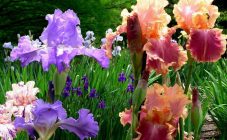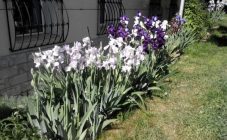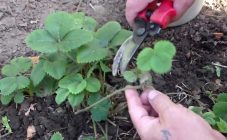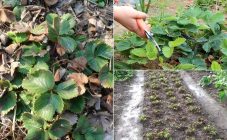Content:
Many gardeners love to grow irises on their plots. The flower is incredibly decorative, it has many shapes and colors. However, in order for it to please for many years, proper care and pruning is needed.
Why prune irises
It is a perennial that requires careful pruning. During the period of growth and flowering, it requires the removal of aerial parts several times. When to trim irises:
- leaves turned yellow and covered with spots;
- the flowering period is over;
- late autumn and early frosts;
- care requirements for certain varieties.
Each of the reasons implies a different technique and timing when to trim the irises. In addition, there are two types of these flowers that require different care.
Rhizome
Their care is minimal. Remove yellow and dried leaves as needed. In the fall, you can skip pruning unless there are good reasons for this. These varieties have exotic species with spectacular flowers - their fan of leaves is removed by half closer to autumn.
Bulbous
More demanding in care. They are distinguished by the presence of rhizome bulbs. After such varieties have faded, it is necessary to cut off their entire aerial part. The roots of the bulbs are left and try not to damage - this can lead to the death of the flower. The planting material is dried and planted again in the fall. In the northern regions, the flower is planted in spring so that the plant does not freeze in winter.
When to trim the leaves
Pruning is done in case of transplanting or reproduction of a flower. In this case, the leaves are cut almost completely, leaving about a third of the length. Thus, water is retained in the roots for better survival.
If you want to detach young roots, then there is no need to touch the entire rhizome completely. The required part is detached with a shovel, and the rest is covered with earth. Watering is not required after the procedure.
When to trim leaves from irises - a few days before the intended transplant. It is not recommended to touch them during flowering, all procedures are performed after 3-4 weeks. The plant will restore the forces that went into the formation of peduncles, and form more rudiments of young rhizomes.
When the seeds ripen, the bushes also need pruning. After the flower withers, seeds appear in the receptacle. Each variety is capable of propagating by seeds, and for some this method is the only one. All peduncles are cut off, but if they want to propagate the plant, they leave one, removing parts of the bush that have already dried up.
There are varieties that have seeds with a very decorative look. In this case, the dried buds are removed without touching the flower. Iris stinky has beautiful orange seeds, and Belamcanda has black showy seeds.
Is it possible to trim irises in July
The flower begins to bloom one of the first, but depending on the variety, these periods also vary. By flowering, plants are divided into groups:
- early - bloom in May;
- mid-early - flowering closer to early June;
- medium - during June;
- late - in the first half of July.
Some varieties bloom twice in one season - in spring and then in autumn. Thus, in July, when the iris has bloomed, its peduncles are cut off.This is done so that the plant does not expend energy on seeds, but directs all its energy to the buds that have not yet blossomed.
There are varieties that are very easy to sow, if you do not remove the peduncle - this leads to thickening of the plantings in the flower bed. This deteriorates the appearance and provokes nutritional deficiencies in the main plant.
Also, flowers are cut during flowering. This is done with a sharp knife, observing the following guidelines:
- buds that have faded and have a green receptacle are removed;
- when flowering occurs in the active phase, it is important to preserve the buds;
- after the flower has lost its decorative appearance, it is cut at a distance of 2.5 cm from the ground.
Leaves should not be removed during flowering or immediately after. This can even lead to the death of the plant. When pruning the foliage from irises, only the completely yellow or dried tips are removed. When properly trimmed, the green fan will adorn the flower bed all summer long.
Even if the flower has wilted a little, it is not recommended to remove any parts from it. It is necessary to cut the leaves of irises when they turn yellow or dry.
Varieties that bloom twice a year require pruning of stems and leaves. When cutting irises is required for a bouquet, the cut is made almost at the root, without damaging it.
Pruning in the fall
In the fall, pruning is necessary for flowers - this is how the plant prepares for the adverse winter conditions. The procedure is carried out before frost in October - leaves are removed. There are some tips for pruning irises in the fall:
- you need to cut the foliage with a cone, so there will be less moisture on the surface;
- leaves up to 15 cm tall do not touch;
- when irises are cut, the removed parts must be burned;
- the rhizomes are covered with a layer of earth;
- if it is winter with a little snow, then the flowers cover completely.
Thus, when it is time to cut irises for the winter depends on the growing region. Somewhere frosts may come earlier.
Tips and tricks from experienced florists and gardeners
This is a very common plant, with many species, so each grower has his own secrets in caring for him. Here are some tips for flower care:
- So that after flowering the leaves do not turn yellow, the planting material is pre-soaked in copper sulfate. This procedure keeps the plant green until the very frost;
- Only acquired varieties are planted during the period of their acquisition, and already existing bushes are planted in early August. In this case, the planting material is dried for a couple of days and embedded in the ground with a rhizome to the south;
- In order to multiply the desired variety as soon as possible, take the rhizome and cut it in two places to a depth of about 1 cm. Then they dry it a little and plant it. Such a plant produces about 6-7 children. It is important to prepare the site for planting, fertilize and moisturize it well. The babies are separated from the main bush with a small part of the mother liquor - so the young plants will have more nutrients.
By following these recommendations, you can further facilitate plant care. A healthy plant is a beautiful decoration for a garden and a summer cottage!















